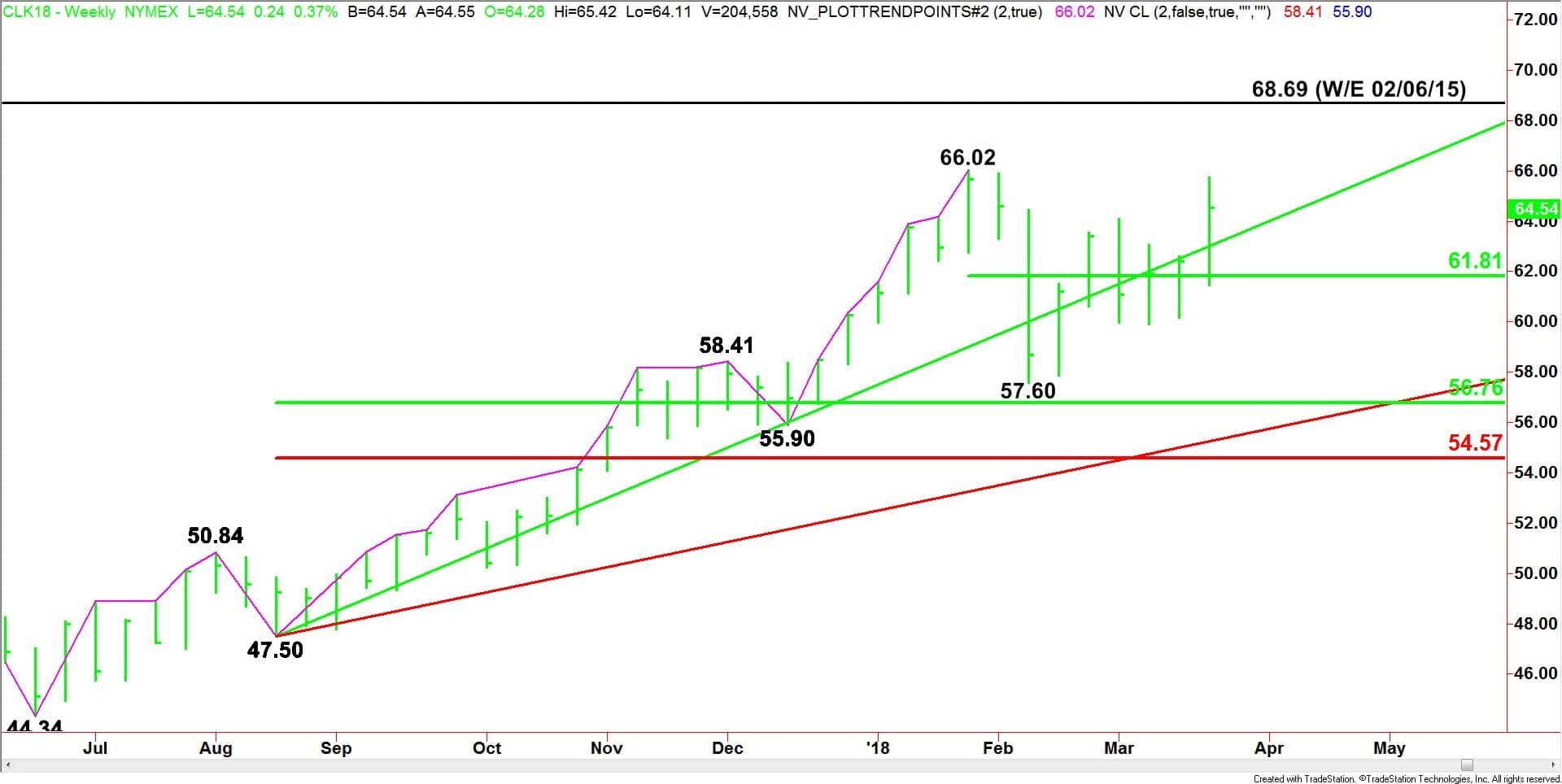Only a week ago, crude oil seemed poised to move lower. At that time, hedge fund liquidation and rising U.S. production were driving the price action. This week is a different story. The facts about rising U.S. output remain the same, but it appears that sentiment is driving the price action at this time. Therefore, we have to conclude that prices will remain elevated until the speculators stop buying.
This week, U.S. West Texas Intermediate and international-benchmark Brent crude oil moved to their highest levels since February 1 after the government reported a surprise decline in U.S. inventories. Other catalysts behind the rally were Middle East tensions and worries about Venezuela’s production slide.
According to the U.S. Energy Information Administration (EIA), crude oil inventories declined 2.6 million barrels the week-ending March 16. Analysts were looking for a 2.5 million barrel build.
The EIA also reported a 1.7-million-barrel drop in gasoline inventories. Gasoline production averaged 9.9 million barrels in the week to March 16, with refineries operating at 91.7 percent of capacity and processing 16.8 million barrels of crude daily.
Additionally, crude imports dropped by half a million barrels per day, that contributed to the draw. Exports were up slightly.
Speculation that the United States may reimpose sanctions on Iran also helped boost prices because this would lead to a disruption of supply.
While it may be true that the U.S.…
Only a week ago, crude oil seemed poised to move lower. At that time, hedge fund liquidation and rising U.S. production were driving the price action. This week is a different story. The facts about rising U.S. output remain the same, but it appears that sentiment is driving the price action at this time. Therefore, we have to conclude that prices will remain elevated until the speculators stop buying.
This week, U.S. West Texas Intermediate and international-benchmark Brent crude oil moved to their highest levels since February 1 after the government reported a surprise decline in U.S. inventories. Other catalysts behind the rally were Middle East tensions and worries about Venezuela’s production slide.
According to the U.S. Energy Information Administration (EIA), crude oil inventories declined 2.6 million barrels the week-ending March 16. Analysts were looking for a 2.5 million barrel build.
The EIA also reported a 1.7-million-barrel drop in gasoline inventories. Gasoline production averaged 9.9 million barrels in the week to March 16, with refineries operating at 91.7 percent of capacity and processing 16.8 million barrels of crude daily.
Additionally, crude imports dropped by half a million barrels per day, that contributed to the draw. Exports were up slightly.
Speculation that the United States may reimpose sanctions on Iran also helped boost prices because this would lead to a disruption of supply.
While it may be true that the U.S. may reimpose sanctions on Iran, it is also true that this news won’t stop U.S. production. So we will expect to see higher prices until a big seller steps in to stop the rally with enough volume to scare the speculators out of the market.
On Thursday, prices retreated on the heels of a huge reversal top on the daily chart. The move was fueled by worries of a possible trade war between the United States and China.
To recap the big event on Thursday, President Trump signed a presidential memorandum that could impose tariffs on up to $60 billion of imports from China, while the world’s second-largest economy countered with its own plan on Friday to impose tariffs on up to $3 billion of U.S. imports.
Trump’s proclamation was followed by a potentially bullish statement by Saudi Arabian Energy Minister Khalid al-Falih, who said that OPEC members will need to continue coordinating with Russia and other non-OPEC oil-producing countries on supply curbs in 2019 to reduce global oil inventories.
The quote from Falih that is driving the price action today is as follows: “We know for sure that we still have some time to go before we bring inventories down to the level we consider normal and we will identify that by mid-year when we meet in Vienna. And then we will hopefully by year-end identify the mechanism by which we will work in 2019.”
Weekly Technical Analysis

(Click to enlarge)
The main trend is up according to the weekly swing chart. After several weeks of lost momentum, highlighted by a sideways to lower trade, crude oil came back with a vengeance this week and is now in a position to signal a resumption of the uptrend on a sustained move over $66.02.
The short-term range is still $66.02 to $57.60. Its 50% level or pivot at $61.81 is support. Holding above this level will help maintain the upside bias.
Last week, the buying was strong enough to recapture an uptrending Gann angle, moving at a rate of $0.50 per week from the $47.50 bottom from the week-ending August 18, 2017. This move is also helping to generate an upside bias.
The angle moves up to $63.50 next week and will once again be very important to the structure of the market, providing both support and direction.
Weekly Forecast
Fundamentally, we’re going to be looking for the upside momentum to continue as long as investors maintain their focus on uncertain events including tensions between Iraq and Saudi Arabia as well as whether the OPEC-led production cuts will be extended beyond 2018.
Additionally, a weaker U.S. Dollar due to fears of a trade war will also make dollar-denominated crude oil a highly desired asset.
The unknown bearish fundamental event will be the shedding of higher-risk assets. If stock market investors continue to liquidate their long positions, then combined with elevated volatility levels in the equity markets, we could see downside pressure on crude oil.
Technically, prices will have to hold above the Gann angle at $63.50 in order to maintain the strong upside bias. Crossing to the weak side of the 50% level or pivot at $61.81, however, will likely fuel an acceleration to the downside.
The only thing we can count on at this time is elevated volatility levels. In the meantime, the battle between the bulls and the bears will continue given the news. Bullish traders, led mostly by speculators are scaring the short-sellers out of the market. They are basing their buying on tensions between the Saudis and Iran as well as low inventories that are scraping the bottom of the five-year range and expectations of accelerated demand as the spring driving season approaches.
Bearish traders, on the other hand, are basing their positioning on expectations of increased U.S. production. Friday’s U.S. rig count could make the difference as to whether we close higher or lower for the session.















